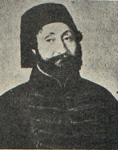

- * The Mehter is sovereignty!
- * The Mehter is grandeur!
- * The Mehter is independence!
- * The Mehter is an oath, a prayer, an entreaty, an applause!
- * The Mehter is the voice of the Turkish nation dispersed to continents!

Turks, before the Common Era, used to play musical instruments in bands of military troops. In Orhun (Göktürk) Epitaphs inscribed in the VIII century the 'tuğ' band, considered to be the predecessor of the Mehter is mentioned. 'Divan-ı Lügat-it Turk', (The Book of the Word of Turk) written by Kaşgarlı Mahmut in the XI century tells of 'nevbet', (chant) beating, before the khan.
Turks, who said: “Roared the cloud, beat the band the chant, flashed the lightning, drew the khan his ensign”, took with them their traditions from Central Asia to Anatolia. The tradition of the drum, flag and ensign, symbols of sovereignty, was spread to the whole Islamic world through Turks. The tradition of beating 'nevbet' continued all the time through the Karahans, Seljuks, İlhans, Memluks to the Ottoman.

The Mehter has, since the first Turkish state in history, been an element not only supporting, encouraging and satiating the spirit of the Turkish land armies, but also an element representing the emotions of a victorious nation.
Turkish history is known with military achievements and victories worldwide. The historical tradition of supporting military campaigns with imposing drums and special rhythms were continued in the armies of many Turkish states in the timeframe from the Huns to present.

This tradition that started initially with ensign and drum grew and flourished in time. Thus the tradition of the Hun Turks of stomping ensign transformed to 'tabl-hanes' (large drums) in the Seljuks period and 'Mehterhanes' , a band of varied instruments, in the Ottomans. The Mehter in this period maintained its significance as it satisfied the need for music in the army, the fortresses and, in fact, of the public.
The Mehter Band, which was continuously improved and renovated during the course of history to the whole world in the timeframe from the Turk states until the Ottoman in terms of geographical expanse of these states. It is known that from the beginning of the XIX century onwards Mehter bands were established first in Prussia, then in countries such as Russia, Poland and Germany formed ensign bands.
During the late Ottoman period, Mehter bands that were closed down with the corruption of the Mehter organization have come to present as military bands that evolved in Europe.

From 1911 onwards, starting with the Second Constitutional Monarchy actions to rejuvenate the Mehter organization were taken and it re-appeared on the historical stagebeing subordinate to "Müze-i Asker-i Osmani", the Ottoman Military Museum. This band established under the name 'Mehterhane-i Hakanî' , The Khan's Mehter Band, assumed effective role in certain fronts during the First World War from 1914 to 1918 and in the 'Kuvva-i Milliye', the National Forces action during the War of Independence.

During the process of re-establishment of the Mehter in 1952 great and meticulous efforts were dispensed and accordingly an original-like team was formed. During re-establishment period, Surname-i Vehbi Miniatures in the Topkapı Palace Miniatures and Manuscripts collection, Mahmut Şevket Pasha’s work titled Ottoman Military Organization and Apparel and other historical documents such as Arifi Pasha’s Mecmua-i Tesavir-İ Osmaniye were taken into consideration.
The Mehter Band Company operating under the Military Museum and Cultural Complex Commandment's organization beats 'nevbet' five days a week as a symbolic expression of the past. The Mehter Band takes us through the pages of the Turkish history. Giving voice to Turkish bravery music country and worldwide they elate the public. The Mehter band that made history in winning wars carries the breath of victory to our day. The Mehter band is indispensible to ceremonies.
Çorbacıbaşı

He is the company commander and a high-ranking officer. He is a conservatory graduate. He is highly knowledgeable about Turkish music and capable of representation. He is the administrative chief of the Mehter band. He is responsible for the continuity of the professionalism, its command and control, training, discipline and administration works and safety of the Mehter. He organizes work he deems necessary in preparation of concerts, marches and ceremonies. The headwear of Çorbacıbaşı who marches before the Mehter is 'üsküf'. A peacock feather decorates the üsküf. He wears a red robe and 'şalvar', baggy trousers, with three rows of yellow decoration on the sides and a waist sash with his gun. On his feet are yellow boots.
Mehterbaşı


Mehterbaşı is the person responsible for the performance of the mehter as the second highest authority following the company commander titled Çorbacıbaşı. He prepares the mehter to the utmost in musical terms. To that end, he prepares daily exercise programs and attends joint exercises ('meşk's). In these exercises he combines the work that the groups of musicians prepared by themselves to make a joint concert program. The performance of the Mehteran Company concerts, their organization and order, additionally, the selection of the performers is the responsibility of the mehterbaşı. Every day, he determines the pieces to be performed in the then concert or activity and distributed them to the groups. Related to the new pieces to be included in the mehter performance, the mehterbaşı exercises performers to have them learnt those by heart. Mehterbaşı is a member of the “Mehter Research Council”.
